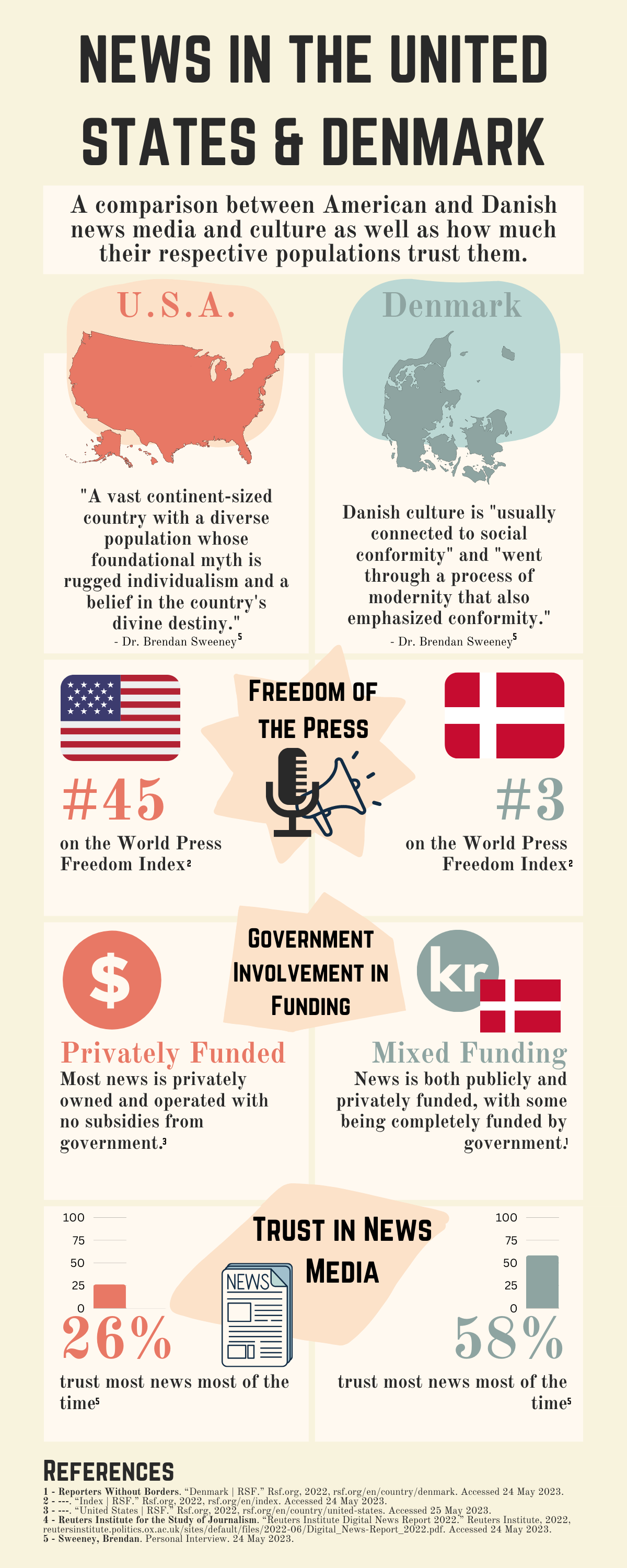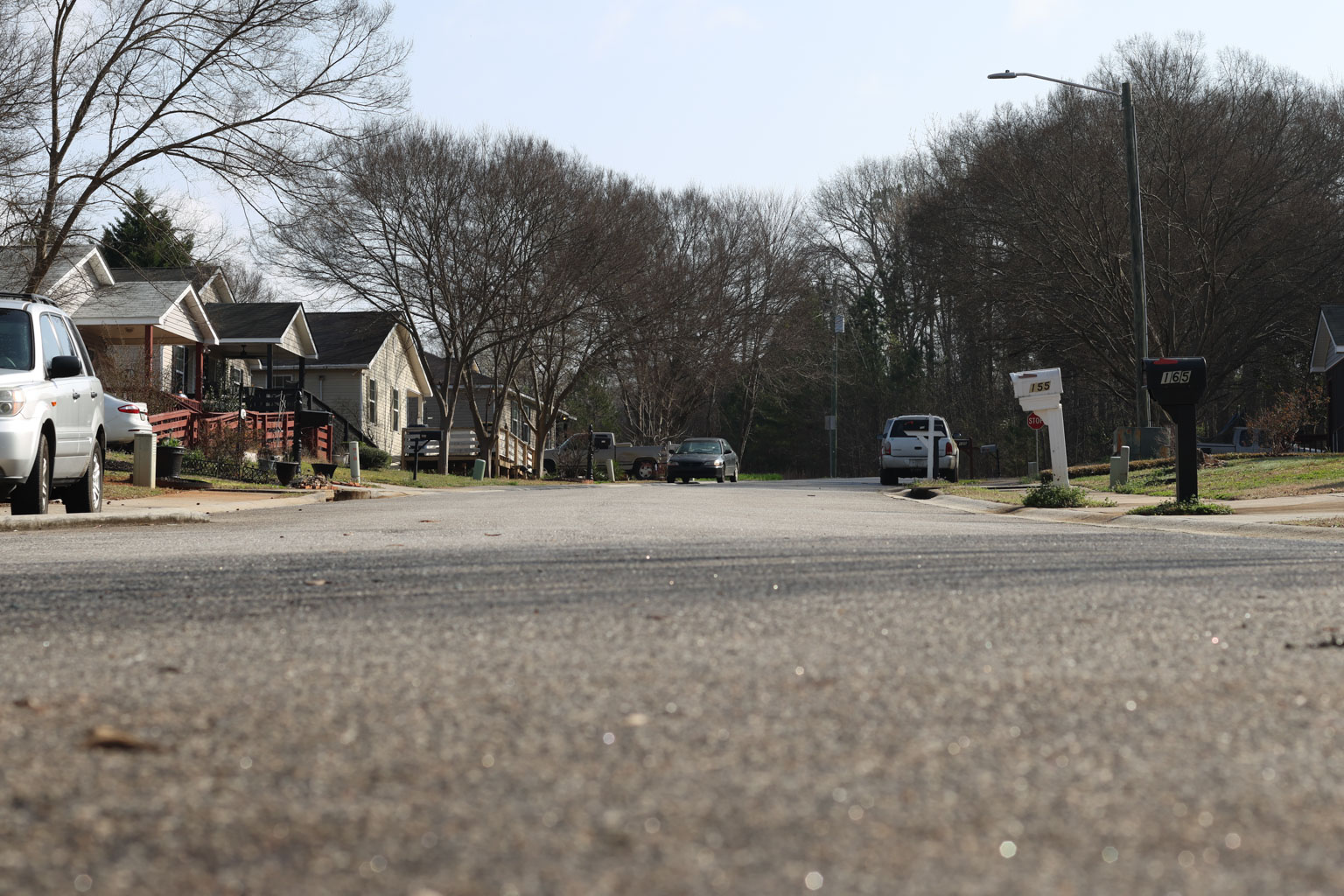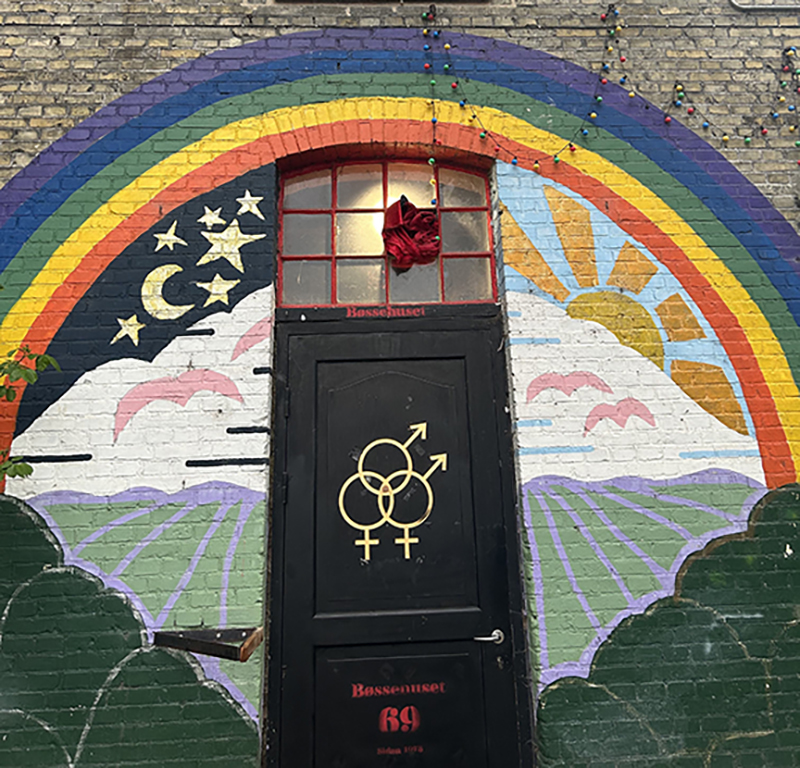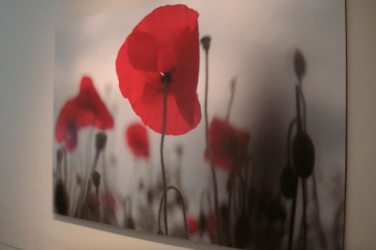Denmark is known for its culture of trust, with trust considered “the basis of most social interactions as well as business and government,” according to the Ministry of Foreign Affairs of Denmark.
“Denmark is off the scale in trust,” said Brendan Sweeney, a Danish Institute for Study Abroad Copenhagen Faculty member. Sweeney described how this trust could be seen in Denmark’s “welfare state of thinking” and extends to not only Danish culture and government but also Danish news media.
Why It’s Newsworthy: 58% of the Danish population trusts most news most of the time, according to the Reuters Institute. The culture of trust and constructive journalism practices found in Denmark could explain this high percentage with 57% of Danish adults preferring constructive news over conventional news, according to Epinion. This approach to news could provide an example for other countries to follow.
A Culture of Trust
Journalism is heavily subsidized by the government in Denmark. However, Sweeney explained that there is no government influence in Denmark’s journalism. He described how the Danish government does not give money directly to media outlets. Instead, it goes through a board that decides which outlets will receive how much money. The government also acts under the arm’s length principle, which means the government cannot tell media outlets what news they can or cannot produce.
Approximately 79% of the Danish population trusts their national government, according to the Wellcome Global Monitor. This trust is part of why the Danish population allows its government to fund media outlets without worrying about government influence in the media.
“I think in Denmark, we just learn to trust authorities in every regard,” said Katrine Aaberg, a resident of Copenhagen. “I think we see media as an authority as well.”
Aaberg explained that in contrast to Denmark, the populations of other countries would be a lot more distrusting of the government because of corruption and apply that same thought process to the media. She affirmed that Danes just hope that big media outlets are not being biased.

A culture of trust enables a productive and trustworthy news media. However, Sweeney explains that this culture does not come without its drawbacks.
“Danish journalism can be toothless at times,” Sweeney said. “The relationship between journalists and politicians can be too cozy. Journalists don’t ask the difficult questions they’re supposed to be asking.”
Although high trust may have a connection to a lack of criticism, Denmark’s news system is still very healthy overall, Sweeney explained.
Constructive Journalism Practices
Constructive journalism is a type of journalism that aims to develop fair, accurate news that counters the sensationalism and negativity often found in present-day media, according to the Constructive Institute. It focuses on facilitating conversations about solutions to problems and leaving the audience “inspired, hopeful and motivated,” according to the Constructive Institute.
TV2 Fyn, a regional TV station based in Funen, Denmark, is practicing constructive journalism to better serve the public through their news.
“For me, it’s journalism that makes the society better or takes society in a different direction,” said Lasse Nielsen, the editor-in-chief at TV2 Fyn. “It is just what good journalism has always been supposed to be. It’s nuanced, balanced and fair.”
Nielsen explained that TV2 utilizes constructive journalism to aim for higher goals than simply providing news to the public. Through surveys conducted, the news organization discovered that the general Danish population thought of them as being a sour media that always pointed out the negative news.
“We wanted to take a step in the middle of the room and try to make partnerships with the municipalities and the people in power,” Nielsen said. “Maybe we should help them do something good instead of pointing at them.”

This approach to journalism has led to many successful projects. For example, TV2 produced “Solved or Crushed,” a show in which Danish politicians are locked in a room and have 20 minutes to negotiate a solution to a current problem in Denmark. The room shrinks as time progresses, and if they do not all agree on a solution within the allotted time, then the politicians lose the game.
TV2 developed “Solved or Crushed” to be both engaging and beneficial to the public; the show entertained its Danish audience while also making politicians negotiate on issues that impacted the Danish public. Nielsen explained that TV2 decided what issues the politicians would be attempting to negotiate on “Solved or Crushed” based on polls they conducted inquiring what issues in Denmark their audience wanted politicians to address.
Nielsen also noted that many of the solutions that politicians decided upon were ultimately implemented into Danish government decision-making, thus solving some of the problems that many Danes noticed in their community.
While constructive journalism leads to projects such as “Solved or Crushed” that benefit the public, it also includes the risk of generating the “cozy” relationships between journalists and politicians that Sweeney discussed.
“We try to be really transparent about our role, but there is a constant danger in being too close with your sources,” Nielsen said.
Nielsen explained the difficult balance of working with politicians while remaining critical of them; TV2 must be able to develop critical, investigative journalism when politicians do something wrong, but at the time, the news station does campaigns with politicians and sees them as partners in building a better society.
Constructive journalism appears to gain the trust of the Danish population despite the associated risks.
“It makes sense to do journalism that way,” Aaberg said. “A lot of people are doing [news] for clickbait and stuff, but I know DR and TV2 do longer articles and more in-depth journalism. So, I think as a reader, you want to get a bigger story on these things and not just a reason just to click a headline.”
Nielsen attested to the trust that constructive journalism gained, noting a small rise in trust after switching to a constructive journalism approach. He also explained the challenges that surround maintaining public trust.
“I think people need to look at us and think ‘They don’t have their own agenda. Their agenda is our agenda,’” Nielsen said. “They need to think that we are doing work for them. We’re describing ourselves as servants more than journalists. We serve the public, and if people feel and think that we serve them, then that creates trust.”
Learning from Denmark
Both cultural trust and constructive journalism contribute to Danish news trust. However, attempting to transfer these factors to another country such as the United States for higher news trust will have varying results; both Sweeney and Nielsen convey that Danish cultural trust could not feasibly be brought into American culture.
“Denmark is founded on that thought that we all put in something, and we all get something back,” Nielsen said.
Nielsen explained that Denmark’s trustful culture has “always been a Danish thing, ever since the Vikings.”
This level of trust would not translate to American culture easily. Sweeney said the U.S. is a vast continent-sized country with a diverse population whose foundational myth is rugged individualism.
“The Danish national myth is almost the opposite,” Sweeney said. “Danish national destiny has mostly involved Denmark losing territory and becoming more homogeneous. Danishness is usually connected to social conformity … I think it’s unlikely that the U.S. can learn much from Denmark.”
Despite these differing cultures, the United States could still learn from the constructive journalism approach and apply it to its own journalism practices.
TV2 is publicly funded, which enabled it to experiment with the constructive approach without having to worry about making a profit, Nielsen explained. In a private media sector such as America’s, “all news media has to make money, and that’s a different ballgame” that can shift the mindsets of news outlets to generating attention and revenue rather than productive journalism.
However, America’s privately operated media would not inhibit constructive journalism from developing in the United States.
“I think there’s good value in doing constructive journalism, because people, I think, will pay for it,” Nielsen said. “If they find a media that they think could do something good for society, I think that could be a business model.”
American trust in news is currently the lowest in the world with only 26% of the American population trusting most news most of the time, according to the Reuters Institute. This distrust is especially apparent to international onlookers.
“From the news that I see in America, it seemed very divided,” Aaberg said. “I know also, politically, maybe America is a little bit more divided than Denmark is because of the two political parties.”
Although there is significant division in American culture and politics, that does not mean that a higher level of trust cannot be established in the United States. Similar to Danish constructive journalism, the United States has been developing solutions journalism.
Solutions journalism is “rigorous and compelling reporting about responses to social problems,” according to the Solutions Journalism Network. This type of journalism has been gaining popularity in the United States; solutions journalism stories have a broad appeal that transcends both age and political differences, according to SmithGeiger.
Solutions journalism also has the potential to increase American news trust if it is further implemented in American news media; 83% of respondents surveyed by SmithGeiger said that they trusted a solutions-focused story while just 55% said they trusted a problem-focused story.
The concept of solutions journalism is very similar to that of constructive journalism. However, there is one key difference in public involvement. Nielsen explained the more active approach that constructive journalism takes at TV2.
“The public needs to be involved in journalism … they have to interact with us,” Nielsen said.
Utilizing both solutions journalism and constructive journalism in the United States to facilitate conversations about the country’s problems and potential solutions to those problems could be a step in the right direction.
“Trust comes from actions,” Nielsen said. “You can’t sit in a corner and wait for trust to happen. It’s the actions you do that create trust.”
Mason Brock is a junior majoring in public relations in the Grady College of Journalism and Mass Communication at the University of Georgia.









Show Comments (0)